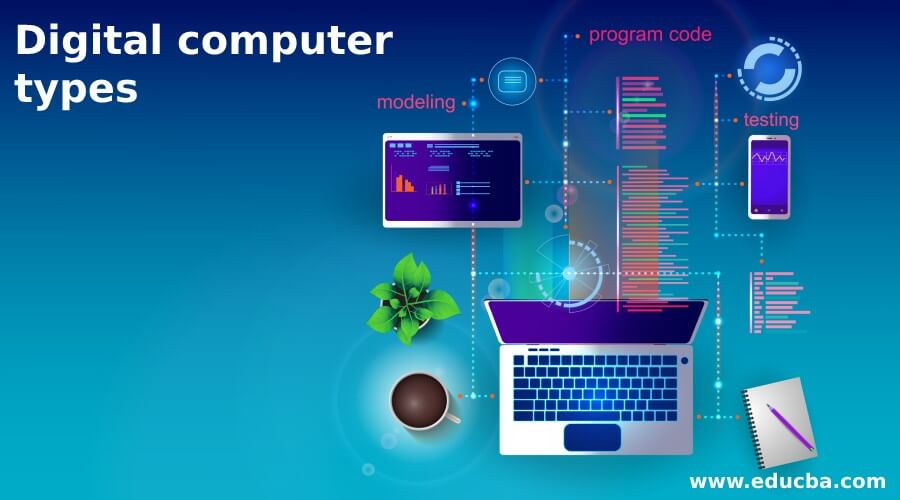Updated August 10, 2023
Introduction to Digital Computer
A digital computer is a digital system that performs various computational tasks. To perform tasks, the digital computer uses a binary number system with two digits, 1 and 0. People call a binary digit a bit. It uses electronic technology to generate, process, and store different data types. The classification of digital computers is based on their types and sizes, which can be divided into four categories: microcomputers, minicomputers, mainframe computers, and supercomputers. In this article, we will discuss the types of digital computers in detail.
Various Types of Digital Computers
Given below are the various types of digital computers:
1. Microcomputer
A microcomputer is a small, relatively inexpensive computer with a microprocessor as its CPU ( Central Processing Unit). It comprises a microprocessor, memory, and minimal input/output (I/O) circuitry mounted on a single printed circuit board (PCB). Some microcomputer systems include additional components such as timers, counters, and analog-to-digital converters (ADCs). It comes equipped with at least one type of data storage. Usually, the storage type is RAM. Some microcomputers perform the task using ram alone; secondary storage is normally desirable. It uses the keyboard, monitor, and other devices for input and output.
These devices may be integrated or separated. In a computer system, RAM is commonly used for memory storage, and a CPU is integrated with at least one additional less volatile memory storage device on a bus system within a single unit. It allows only one user at a time. To allow more than one user, there is a need for modification in software and hardware. Microcomputers are pretty light and easy to handle because of their small size and feather-like weight. A microcontroller is a microcomputer that consists of a single silicon chip. Everyday household goods such as personal computers, digital watches, microwave ovens, digital TV sets, TV remote control units (CUs), cookers, hi-fi equipment, CD players, personal computers, fridges, etc., utilize these microcontrollers.
2. Minicomputer
A mini computer is a computer that has the same functionality as a large computer but appears in a smaller size. A mini computer is smaller than a mainframe computer but larger than a microcomputer. Mobile phones, tablet PCs, laptops, desktop mini-computer, and high-end MP3 players are examples of minicomputers. Businesses primarily employ mini computers to manage the production process. Mimi computers are less in cost as compared to supercomputers and mainframe computers. It is more powerful than a microcomputer but no powerful as a supercomputer and a mainframe computer. This computer can handle one or more processors. It allows multiple users at a time and supports multitasking and multiprocessing to perform several tasks simultaneously. People commonly refer to minicomputers as “minis.”
3. Mainframe Computer
Large organizations utilize mainframe computers to manage critical operations such as bulk data processing, transaction processing, and enterprise resource planning. The performance is relatively higher than any other system, and many memory and processors are used. These systems are mainly used by large IT companies, Walmart, NASA, etc. It consists of two components JCL and COBOL. JCL is Job Control Language, an authoritative and stretchy language that facilitates operating and customizing remote resources for computers. Business sectors use COBOL as a high-level language to process data, known as Common Business Oriented Language.
The system has a centralized server with multiple operating systems and allows managing the operations centrally. This makes the system efficient with higher performance and less workload to individual operating systems. There is an inbuilt capability in the mainframe computers to process massive chunks of data and support complicated applications to run with high computing speed. Mainframe computers are capable of developing and running complex applications. Mainframe computers use advanced security mechanisms to protect large-scale organizations and provide extra security. Multiple applications can run in the system at a time without affecting the performance of the system.
4. Supercomputer
The supercomputer is a computer with a High level of performance as compared to a general-purpose computer. It is measured in FLOPS (Floating point operations per second) format instead of MIPS (Million instructions per second) to assess its performance. It plays an important role in computer science, used in various fields such as climate research, weather forecasting, molecular modeling, quantum mechanics, o and gas exploration, polymers, biological macromolecules, and crystals.
Scientists and engineers use supercomputers, which are purpose-specific computers, to solve complex mathematical and scientific calculations that demand large memory capacities and exceptional speed for execution. The fastest computers in the world are designed with the specific purpose of solving problems that surpass the capabilities of any other computer. The cost of Supercomputers is quite high. It contains more than one CPU, which interprets the program instructions and executes the arithmetic and logic operation in proper sequence.
Recommended Articles
This is a guide to Digital Computer Types. Here we discuss the introduction and the various digital computer types. You may also have a look at the following articles to learn more –




